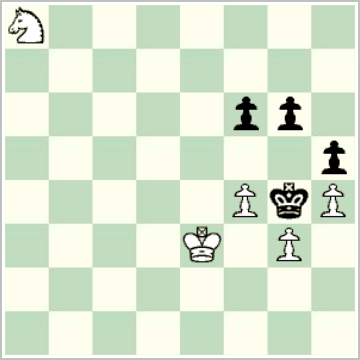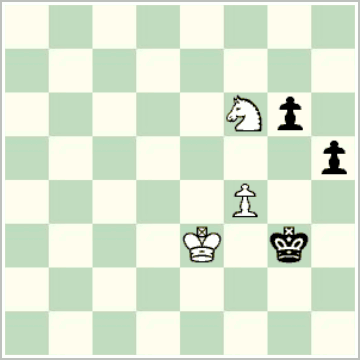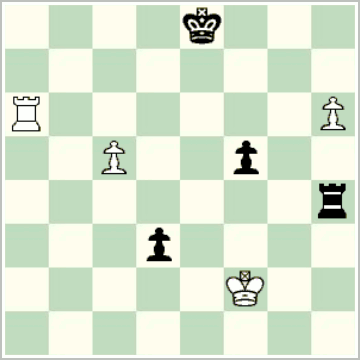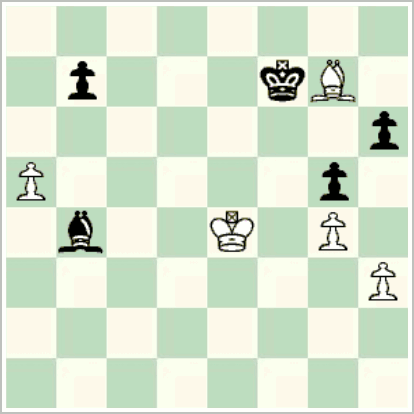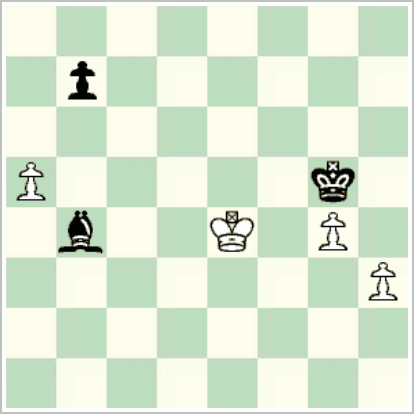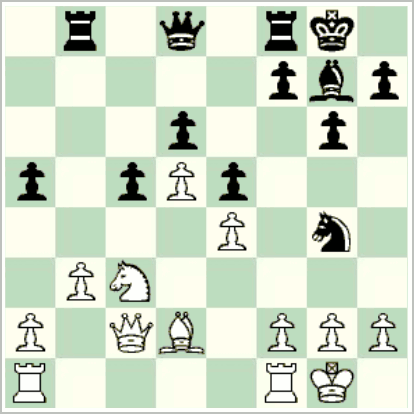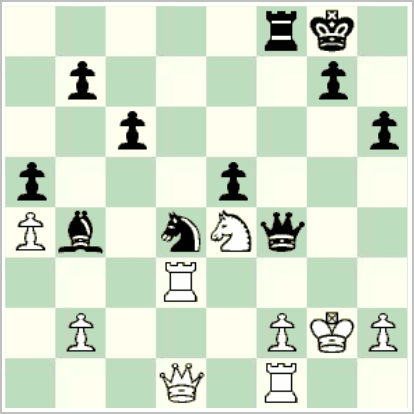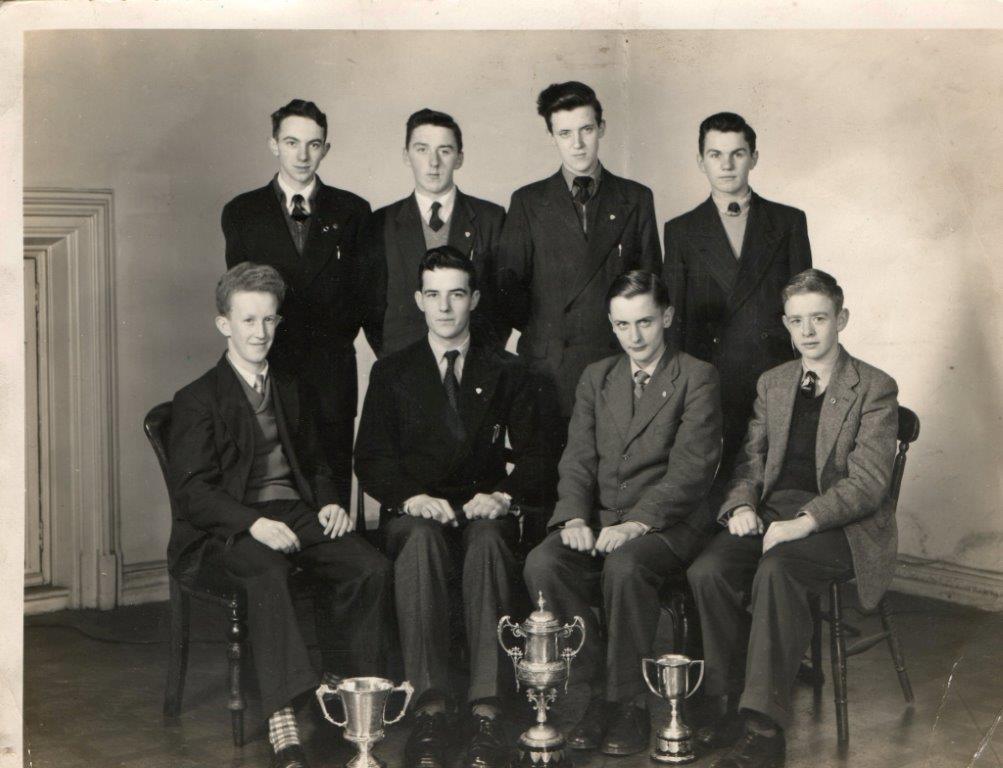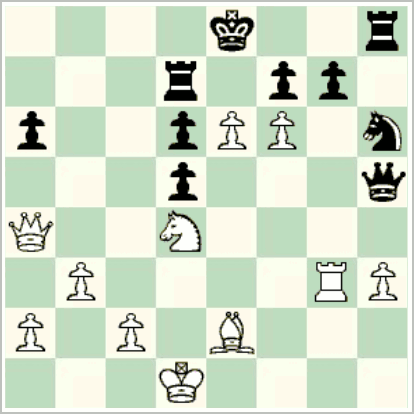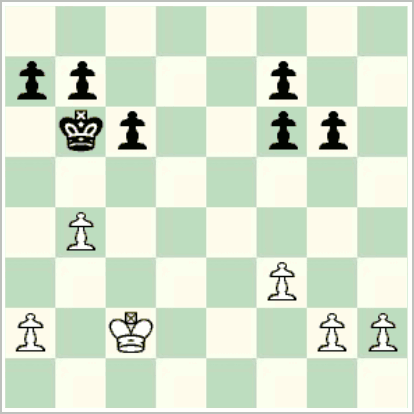The Glorney Cup 1956 was held at Liverpool C.C., from August 1-2, 1956. Once again, four teams participated, and again, only match results counted.
In the morning of the opening day, England beat Ireland 5 – 1, and Scotland drew with Wales.
| England |
|
Ireland |
| R. Payne |
1 – 0 |
M. McMahon |
| W. S. Deeth |
1 – 0 |
R. Grogan |
| N. E. Lewis |
0 – 1 |
T. M. Alcorn |
| B. J. McGreevy |
1 – 0 |
A. Coldrick |
| C. F. Girling |
1 – 0 |
D. Kennedy |
| J. C. Dore |
1 – 0 |
D. Déiseach |
|
5 – 1 |
|
| Scotland |
|
Wales |
| M. Fallone |
½ – ½ |
A. J. Davies |
| G. Dickson |
1 – 0 |
P. M. Perry |
| J. Hennigan |
0 – 1 |
F. S. Wusteman |
| J. A. Phillips |
½ – ½ |
D. P. Bryon |
| P. McLaren |
1 – 0 |
W. Gough |
| J. O’Sullivan |
0 – 1 |
B. D. Josephson |
|
3 – 3 |
|
In the evening, England drew with Scotland; this was the first time in Glorney Cup history that England had failed to win a match. Ireland and Wales also drew.
| England |
|
Scotland |
| R. Payne |
½ – ½ |
M. Fallone |
| W. S. Deeth |
0 – 1 |
G. Dickson |
| N. E. Lewis |
1 – 0 |
J. A. Phillips |
| B. J. McGreevy |
½ – ½ |
J. Hennigan |
| C. F. Girling |
½ – ½ |
P. McLaren |
| B. R. Ewart |
½ – ½ |
J. O’Sullivan |
|
3 – 3 |
|
| Ireland |
|
Wales |
| M. McMahon |
½ – ½ |
A. J. Davies |
| R. Grogan |
½ – ½ |
P. M. Perry |
| T. M. Alcorn |
0 – 1 |
F. S. Wusteman |
| D. Déiseach |
0 – 1 |
D. P. Bryon |
| A. Coldrick |
1 – 0 |
B. D. Josephson |
| J. McMahon |
1 – 0 |
M. J. Mears |
|
3 – 3 |
|
On the second day, England beat Wales 4 – 2, while Ireland beat Scotland 3½ – 2½.
| England |
|
Wales |
| R. Payne |
½ – ½ |
A. J. Davies |
| W. S. Deeth |
1 – 0 |
P. M. Perry |
| N. E. Lewis |
1 – 0 |
F. S. Wusteman |
| B. J. McGreevy |
½ – ½ |
D. P. Bryon |
| B. R. Ewart |
0 – 1 |
M. J. Mears |
| J. C. Dore |
1 – 0 |
W. Gough |
|
4 – 2 |
|
| Ireland |
|
Scotland |
| M. McMahon |
0 – 1 |
G. Dickson |
| R. Grogan |
1 – 0 |
M. Fallone |
| T. M. Alcorn |
1 – 0 |
J. A. Phillips |
| D. Déiseach |
0 – 1 |
J. Hennigan |
| D. Kennedy |
1 – 0 |
P. McLaren |
| J. McMahon |
½ – ½ |
J. O’Sullivan |
|
3½ – 2½ |
|
So England won yet again, though the BCM reported that “it was a less convincing win than in previous years due to the considerable improvement in the standard of play that has taken place in the other countries competing”. Ireland finished second, while Scotland and Wales tied for third and fourth places.
|
eng |
irl |
sco |
wls |
mp |
gp |
| England |
. |
5 |
3 |
4 |
5 |
12 |
| Ireland |
1 |
. |
3½ |
3 |
3 |
7½ |
| Scotland |
3 |
2½ |
. |
4 |
2 |
9½ |
| Wales |
2 |
3 |
3 |
. |
2 |
8 |
No games are available.
The Irish team was Michael McMahon (O’Connell’s School, Dublin & Kevin Barry C.C.), b. 1938, Irish Schoolboys’ champion 1956 (biographical note), Richard Grogan (Synge St. C.B.S., Dublin), 1938-2016, Irish Schoolboys’ champion 1954, Leinster Schoolboys’ champion 1956 and Olympiad team member 1956 (obit.), Tom M. Alcorn, 1940-2003 (Royal Belfast Academical Instiution & C.I.Y.M.S. C.C.), Ulster Schoolboys’ champion 1956, Art Coldrick (O’Connell’s School, Dublin & Phibsboro C.C.), b. 1941, Olympiad team member in 1972, David Kennedy (Terenure College, Dublin), Donal Déiseach 1938-2018 (Coláiste Mhuire, Dublin, & Clontarf C.C.), Irish Schoolboys’ champion 1955, and John McMahon (O’Connell’s School, Dublin & Kevin Barry C.C.), 1940-2021. Of these, Alcorn, Coldrick, and John McMahon made their débuts. Michael and John McMahon are brothers; this was the first time that two brothers had played for the same Glorney Cup team. The manager was Tom Conlon, who had played in 1949 and 1950.
The English team was Roland Payne (Southend), ca. 1938-2014, London Boys’ champion 1956, William Stanley Deeth (Harrow County School), London Schoolboys’ champion 1955, Neil E. Lewis (Birmingham), Bruce John McGreevy 1938-2020 (Liverpool), Clive F. Girling (Gravesend, Kent), joint British Boys’ champion 1956, John C. Dore (Birmingham), and Brian R. Ewart (Wallasey, Merseyside), b. 1939. Payne, Girling, Dore, and Ewart made their début.
The Scottish team was Michael Fallone (Our Lady’s, Hamilton), b. Bellshill, Lanarkshire, 1938, later Scottish champion (1963), Olympiad team member in 1956, 1964, and 1966 (biographical sketch), George Dickson (Edinburgh), 1938-2017, Scottish Boys’ champion 1955 (obit., biographical sketch, photo, 2015), John Hennigan, John Andrew Phillips (Edinburgh), b. 1938, P. McLaren (Edinburgh), and J. O’Sullivan. Of these, Hennigan, McLaren, and O’Sullivan made their début. John Hennigan is the father of IM Michael Hennigan, British champion in 1993.
The Welsh team was Anthony J. Davies ([Bishop Gore School,] Swansea), P. M. Perry ([St. Illtyd’s College,] Cardiff), Frederick Stephen Wusteman (St. Illtyd’s College, Cardiff), D. P. Bryon ([St. Illtyd’s College,] Cardiff), W. Gough (Whitchurch G.S., Cardiff), B. D. Josephson (Cardiff High School), and M. J. Mears (St. Illtyd’s College, Cardiff). (Here, square brackets denote school affiliations from the previous year.) Of these, Gough, Josephson, and Mears made their débuts.
The top scorers for each team were Dore (England), 2/2, (Payne, Deeth, Lewis, and McGreevy scored 2/3), Alcorn (Ireland), 2/3, Dickson (Scotland), 3/3, and Wusterman and Bryon (Wales), 2/3.
A photo of all players and officials was given to the players and appeared in CHESS the following month. (See the Scottish Teams in the Glorney Cup page in the Chess Scotland web pages for a much higher resolution copy of the picture.)
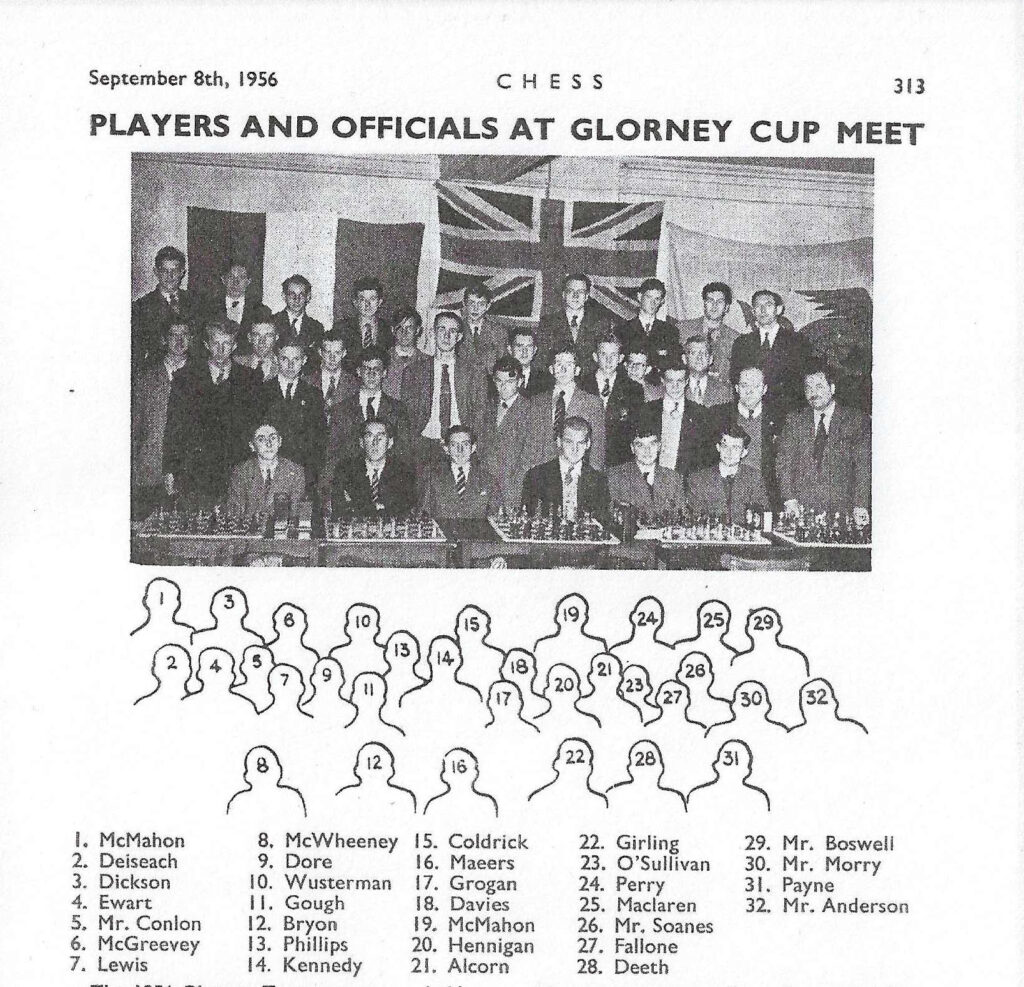
The key lists two players as ‘McMahon’. Many thanks to their brother, and later Glorney Cup player himself, Frank, who identifies 1 as John McMahon and 19 as Michael McMahon. The other Irish players in rough board order are Richard Grogan at 17, Tom Alcorn at 21, Dónal Déiseach at 2, Art Coldrick at 15, and David Kennedy at 14. The Irish manager Tom Conlon is at 5.
(In this photo, who is McWheeney, who appears at 8? He looks as if he is a player, but his name does not appear on any scorecards.)
- Sources:
- BCM 1956 p. 234 (all match scorecards)
- CHESS, vol. 21, September 8th, 1956 p. 313 (match results, photo of all participants with key)
- Ficheall, no. 6, January 1957, p. 8 (summary report with match point totals, overall outcomes of Ireland’s matches, and team composition; Alcorn Ulster Schoolboys’ champion 1956 and top scorer, his score given as 2½/3)
- Belfast News-Letter, April 11, 1956 p. 7 (Alcorn club)
- Belfast Telegraph, February 27, 1956 p. 10 (Alcorn Ulster Schoolboys’ champion 1956, Alcorn school, photo of Alcorn and Harry Harte), August 2, 1956 p. 10 (summary report on first day’s matches, with some inaccuracies)
- Cork Examiner, August 2, 1956 p. 11 (partial match scores after round 2), August 3, 1956 p. 11 (final game totals, and corresponding places if game totals had counted, i.e., Scotland – Wales – Ireland, and with incorrect total for Ireland)
- East Kent Times & Broadstairs Mail, May 2, 1956 p. 9 (Payne London Boys’ champion)
- Evening Herald, August 2, 1956 p. 3 (scores of matches from first two rounds)
- Harrow Observer, July 21, 1955 p. 1 (Deeth school, London Schoolboys’ champion)
- Irish Independent, January 13, 1956 p. 12 (Coldrick club), April 7, 1956 p. 16 (Grogan Leinster Schoolboys’ champion 1956), July 6, 1956 p. 13 (schools of Coldrick, Déiseach, Kennedy, John McMahon, details of qualifying tournament), July 14, 1956 p. 14 (Michael McMahon Irish Schoolboys’ champion 1956; Déiseach earns place via qualifying tournament), August 1, 1956 p. 11 (Irish team, Michael McMahon Irish Schoolboys’ champion, Alcorn Ulster Schoolboys’ champion, incorrectly giving F. McMahon instead of John McMahon), August 2, 1956 p. 9 (scorecards for Ireland’s first two matches), August 3, 1956 p. 10 (final scores, scorecard for Ireland’s last match)
- Irish Press, March 6, 1956 p. 11 (club of Michael and John McMahon), August 1, 1956 p. 8 (Irish team, Michael McMahon Irish Schoolboys’ champion, Alcorn Ulster Schoolboys’ champion), August 2, 1956 p. 9 (scorecards for rounds 1 and 2), August 3, 1956 p. 10 (final scores, scorecard for round 3)
- Irish Times, July 5, 1956, p. 11 (initial selection, including Michael McMahon, Alcorn, Grogan, and Con Deasy, who later dropped out), July 19, 1956 p. 5 (Michael McMahon Irish Schoolboys’ champion, Coldrick and Déiseach earn places from qualifier), August 2, 1956 p. 6 (scorecards of Ireland’s first two matches), August 3, 1956 p. 7 (scorecard of Ireland’s last match), August 9, 1956 p. 6 (tournament review)
- Lancashire Evening Post, August 31, 1956 p. 12 (Girling first name, joint winner of British Boys’ championship, occupation)
- Sunday Independent, July 15, 1956 p. 17 (Coldrick earns place via qualifying tournament)
- The Scotsman, August 2, 1956 p. 8 (partial results of four matches, partial scorecards of Scotland – Wales and England – Scotland)
- Western Mail & South Wales News, April 4, 1956 p. 7 (schools of Wusteman, Gough, Mears), April 5, 1956 p. 8 (same, plus Josephson), August 3, 1956 p. 10 (final game totals, and corresponding places if game totals had counted, i.e., Scotland – Wales – Ireland, and with incorrect total for Ireland), August 21, 1956 p. 5 (Wusteman Welsh Boys’ champion 1956; Dore city)
- 9th Glorney Cup: Liverpool (ENG), 1956, OlimpBase (match scores)
- Scottish Teams in the Glorney Cup (ed. Alan McGowan), Chess Scotland history archive web pages (Scottish team; first name of Hennigan plus link to Michael Hennigan; photo of participants)
- 43rd British Chess Championship, BritBase (ed. John Saunders) (Girling joint British Boys’ champion 1956, first names and cities for Deeth, Dore, Ewart, city for Wusteman)
- 76th Varsity Match, BritBase (ed. John Saunders) (Deeth full name)
- Harrow County School for Boys C.C. web page (re Deeth)
- The nitrogen metabolism of Azotobacter vinelandii : with special reference to the mechanism of fixation, Frederick Stephen Wusteman, Ph.D. thesis, Imperial College London, 1962 (Wusteman full name) (note: name often given incorrectly as “Wusterman” in contemporary chess sources)
- 42nd British Chess Championship, BritBase (ed. John Saunders) (cities for Deeth, Ewart, McLaren, McGreevy)
- 1956 British Chess Federation (BCF) Grading List, BritBase (ed. John Saunders) (McGreevy first name)
- John McMahon, Tom O’Neill, Fank McMahon, The Glorney Cup: Early Years 1948 – 1963, ca. October 2020 (Conlon manager).
[Update, March 12, 2022: Updated John McMahon’s biography to reflect his passing, shortly after this post; modified Coldrick’s biographical sketch to add Olympiad.]
[Update, June 20, 2022: corrected Déiseach’s name (deleting fada in first name), based on his own rendition in Family Life Education in Canadian Schools, Canadian Education Association, June 1977.]
[Update, May 25, 2024: added first name for McGreevy; added reference to The Scotsman; updated entries for Alcorn and Déiseach.]
[Update, May 29, 2024: added middle name and vital dates for McGreevy, based on cited post by Jon D’Souza-Eva at the English Chess Forum.]
